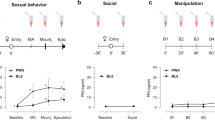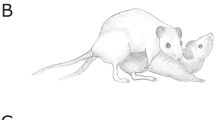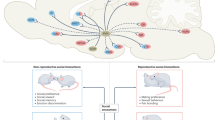Abstract
RHESUS monkeys, like many other primates, do not restrict their sexual activity to the ovulatory period, and copulation may occur at any time during the menstrual cycle1,2. Thus, in the laboratory, the male's ejaculatory frequency is generally highest near mid-cycle (although different pairs show different patterns of mounting and ejaculation3) while, in the wild, sexual activity seems to be more or less restricted to the middle part of the cycle4,5. It is difficult to judge the stage of the cycle in troops of feral rhesus monkeys, but during the period of maximum sexual activity females actively approach males and form temporary consort bonds which involve mutual grooming and frequent copulations6. To obtain an independent and objective measure of female sexual motivation, we have used an operant conditioning technique in which the female was required to press a lever for access to her male partner. This has made it possible to relate changes in female motivation precisely to changes in the circulating levels of ovarian hormones. We have also demonstrated a synchronisation and maximisation of female sexual motivation with male ejaculatory performance during the peri-ovulatory (fertile) period of the menstrual cycle.
This is a preview of subscription content, access via your institution
Access options
Subscribe to this journal
Receive 51 print issues and online access
$199.00 per year
only $3.90 per issue
Buy this article
- Purchase on Springer Link
- Instant access to full article PDF
Prices may be subject to local taxes which are calculated during checkout
Similar content being viewed by others
References
Michael, R. P., and Herbert, J., Science, 140, 500–501 (1963).
Michael, R. P., and Zumpe, D., J. Reprod. Fert., 21, 199–201 (1970).
Michael, R. P., Zumpe, D., Keverne, E. B., and Bonsall, R. W., Rec. Prog. Hormone Res., 28, 665–706 (1972).
Carpenter, C. R., Naturalistic Behavior of Nonhuman Primates (Pennsylvania State University Press, 1964).
Kaufmann, J. H., Ecology, 46, 500–512 (1965).
Altmann, S. A., Ann. N. Y. Acad. Sci., 102, 338–435 (1962).
Michael, R. P., and Keverne, E. B., Nature, 218, 746–749 (1968).
Michael, R. P., Herbert, J., and Welegalla, J., J. Endocr., 39, 81–98 (1967).
Monroe, S.E., Atkinson, L. E., and Knobil, E., Endocrinology, 87, 453–455 (1970).
Knobil, E., Rec. Prog. Hormone Res., 30, 1–36 (1974).
Author information
Authors and Affiliations
Rights and permissions
About this article
Cite this article
MICHAEL, R., BONSALL, R. Peri-ovulatory synchronisation of behaviour in male and female rhesus monkeys. Nature 265, 463–465 (1977). https://doi.org/10.1038/265463a0
Received:
Accepted:
Published:
Issue Date:
DOI: https://doi.org/10.1038/265463a0
This article is cited by
Comments
By submitting a comment you agree to abide by our Terms and Community Guidelines. If you find something abusive or that does not comply with our terms or guidelines please flag it as inappropriate.



